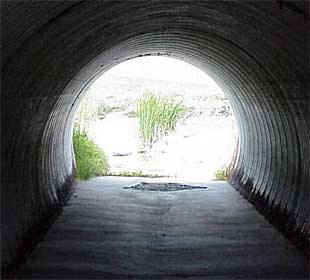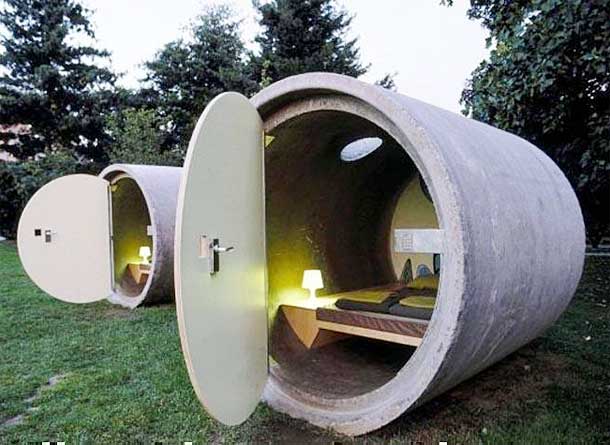Underground Culvert Homes
You've probably heard of root cellars before, but underground
culvert homes are not your grandmother's root cellars. Underground
storage pods and homes are made from culverts once designed as
a way to bridge creeks and now they have been recycled.
 |
The culverts themselves are thin but strong
steel pipes (or concrete). The steel ones are light in weight
considering their size, and inexpensive to use when you
compare them to other construction types. The pipes are
also galvanized, which makes them rust-proof.
|
You can use various sizes of culvert pipes to construct a storage
area or home space. They can basically fit into most any underground
need you might have. Eight or ten foot culverts are especially
roomy for home use.
Underground culvert homes are quickly and easily built. Steel
plates are usually welded on the ends, enclosing the culvert.
Culvert piping is also used for the vent tubes, and these are
usually placed at each end of the culvert. You may opt to use
a smaller diameter of culvert for your entry way.
Tar and Feather, Ye!
The outside of the culvert pipe may be sprayed to prevent rust,
using tar. The interior floor of culvert homes and storage areas
is usually made from one inch plywood and 2 x 4's. The floor is
placed low enough in the pipe so that you'll have plenty of head
room.
The type of doors used on culvert homes varies, depending on
the use of the house. You can also add a porch to your home. Wooden
doors may be used for entryways, with inner steel doors for security.
Walls and shelving are added for security and storage.
Culvert homes can be easily set into the place where you want
them. The hole can be dug in a single day, and the shelter can
be put in place in one day as well, with entrance pipes and vent
pipes welded on. The third day, the culvert pipe will be buried.

For the size of culvert home you need, this type of building
is inexpensive, compared to other building types. Some of the
materials can be reclaimed, making the cost even lower. An average
shelter home may have 250 square feet, with plenty of cubic feet
for storage. Whether you use it to live in, or as a shelter for
emergencies, you can add a bed and dresser, along with a relatively
small living area.
If you are looking at a finished culvert home, you may notice
rock towers on the top. These actually are used to enclose the
shelter vents, so that kids won't be able to shoot any holes in
them. You can even completely hide your culvert structure from
view, which is especially valuable if you want to use it as an
emergency shelter. You can hide the entrance way and the vents
in outbuildings or shrubbery atop the home.
Getting Defensive ...
Some people are setting up culvert homes as defensive shelters,
which will be a place to take cover in the event of severe storms
or nuclear attacks. The people who have these culvert homes built
as shelters use heavy materials for the walls and doors, to make
sure that they will remain safe in place after a storm, earthquake
or some type of attack.
|

